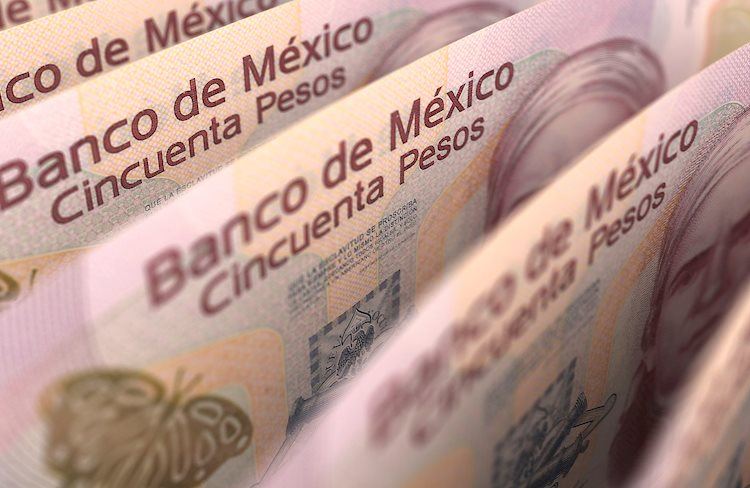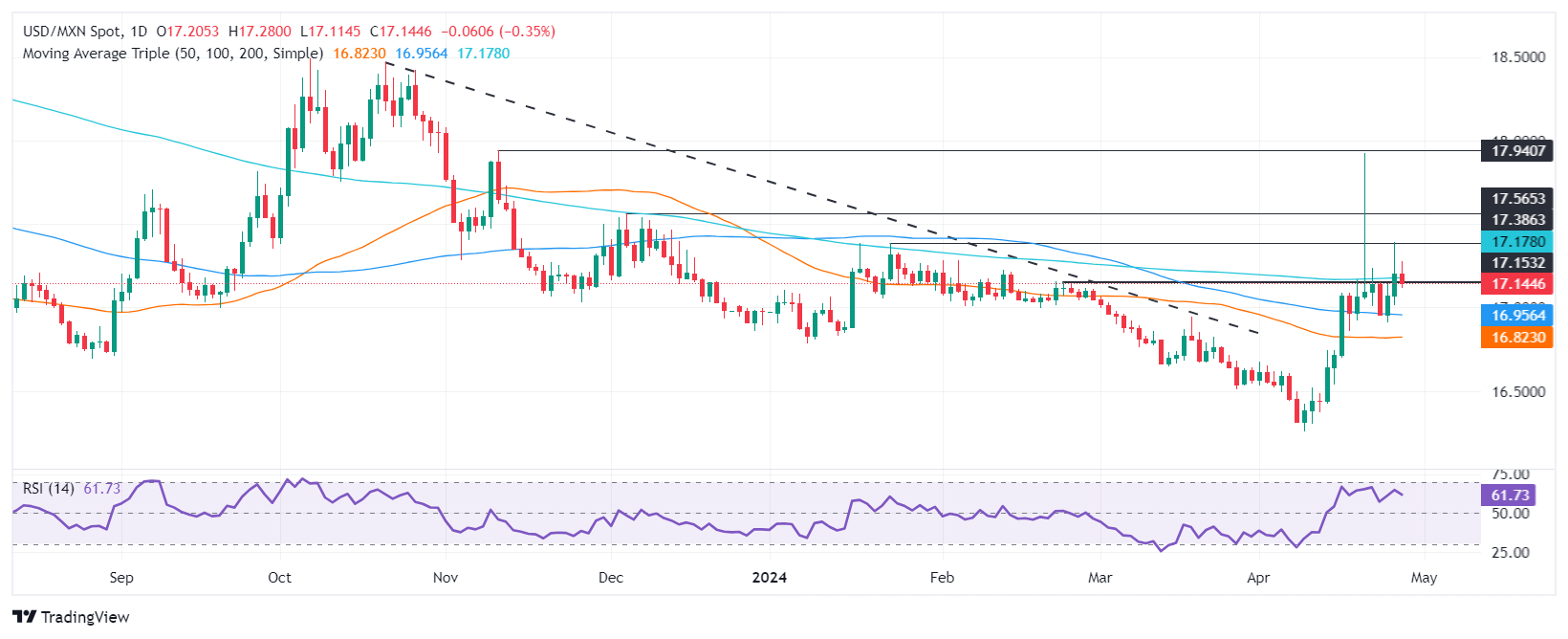- Mexican Peso strengthens against US Dollar, buoyed by positive market mood, mixed economic reports.
- US inflation remains hot as core PCE Price Index increases above March expectations.
- Mexico shows a deficit, yet Unemployment Rate drops, presenting mixed economic scenario.
The Mexican Peso counterattacks registered solid gains versus the US Dollar on Friday as economic data from the United States (US) showed that inflation edged slightly up, while Mexico’s Trade Balance registered a trade deficit in March. The USD/MXN trades at 17.13, down 0.42%.
The US Department of Commerce revealed that the Federal Reserve’s (Fed) preferred gauge for inflation, the core Personal Consumption Expenditure Price Index (PCE), increased above expectations in March. However, annual readings exceeded estimates but were unchanged compared to February.
The National Statistics Agency (INEGI) revealed that Mexico printed a deficit in March when adjusted for seasonal adjustments. At the same time INEGI revealed the Unemployment Rate for the same period was lower than the consensus.
Market mood is another reason the Mexican currency is underpinned as major Wall Street indices clock gains between 1.1% and 2.2%.
Daily digest market movers: Mexican Peso shrugs off hot US inflation data
- As expected, March US core PCE figures came in at 0.3% compared to the previous month’s reading. Annually-based inflation increased by 2.8%, unchanged from February but exceeding estimates.
- PCE Price Index revealed headline inflation of 0.3% MoM, which was aligned with the consensus and unchanged. On a yearly basis, prices increased by 2.7%, up from 2.5%, exceeding forecasts of 2.6%.
- Consumer Sentiment in the United States (US) deteriorated in April, blamed on higher expected prices as inflation expectations rose. The University of Michigan sentiment index fell to 77.2 from 79.4 in March, below estimates of 77.9. Inflation expectations for one year rose by 3.2% over the next twelve months, its highest level since November, up from the 2.9% expected in March.
- In March, Mexico registered a $1,583 million trade deficit when adjusted for seasonal figures, revealing INEGI on Friday. At the same time, the Unemployment Rate was 2.3% for the same period, non-seasonally adjusted.
- Mexican Peso is also supported by the latest inflation report, which revealed that core prices edged lower, but headline inflation is up from 4.48% to 4.63%. This would deter the Bank of Mexico (Banxico) from easing policy at the May meeting.
- Citibanamex Survey showed that most analysts expect Banxico to hold rates unchanged at the May meeting. The median foresees a rate cut in June, while they estimate the main reference rate to end at 10.00%, up from 9.63% previously.
- Banxico Governor Victoria Rodriguez Ceja said that service inflation is not slowing as expected. She added that the Peso’s strength has helped to temper inflationary pressure and lower imported goods. She emphasized that Banxico would remain data dependent.
- Data from the Chicago Board of Trade (CBOT) suggests that traders expect the fed funds rate to finish 2024 at 5.050%, up from 5.035%, on Thursday.
Technical analysis: Mexican Peso appreciates, yet is on thin ice as USD/MXN approaches key level
The Mexican Peso remains on the defensive despite the fact the USD/MXN edged below the 200-day Simple Moving Average (SMA) at 17.16. If the exotic pair achieved a daily close below the latter, that would expose the April 25 low 17.01, followed by the 17.00 mark. A breach of the latter will expose the 50-day SMA at 16.81 before challenging last year’s low of 16.62.
On the other hand, if USD/MXN clears the 200-day (SMA) at 17.16, that would extend the uptrend. The next resistance would be the January 23 swing high of 17.38, followed by the year-to-date (YTD) high of 17.92, ahead of 18.00.
Mexican Peso FAQs
The Mexican Peso (MXN) is the most traded currency among its Latin American peers. Its value is broadly determined by the performance of the Mexican economy, the country’s central bank’s policy, the amount of foreign investment in the country and even the levels of remittances sent by Mexicans who live abroad, particularly in the United States. Geopolitical trends can also move MXN: for example, the process of nearshoring – or the decision by some firms to relocate manufacturing capacity and supply chains closer to their home countries – is also seen as a catalyst for the Mexican currency as the country is considered a key manufacturing hub in the American continent. Another catalyst for MXN is Oil prices as Mexico is a key exporter of the commodity.
The main objective of Mexico’s central bank, also known as Banxico, is to maintain inflation at low and stable levels (at or close to its target of 3%, the midpoint in a tolerance band of between 2% and 4%). To this end, the bank sets an appropriate level of interest rates. When inflation is too high, Banxico will attempt to tame it by raising interest rates, making it more expensive for households and businesses to borrow money, thus cooling demand and the overall economy. Higher interest rates are generally positive for the Mexican Peso (MXN) as they lead to higher yields, making the country a more attractive place for investors. On the contrary, lower interest rates tend to weaken MXN.
Macroeconomic data releases are key to assess the state of the economy and can have an impact on the Mexican Peso (MXN) valuation. A strong Mexican economy, based on high economic growth, low unemployment and high confidence is good for MXN. Not only does it attract more foreign investment but it may encourage the Bank of Mexico (Banxico) to increase interest rates, particularly if this strength comes together with elevated inflation. However, if economic data is weak, MXN is likely to depreciate.
As an emerging-market currency, the Mexican Peso (MXN) tends to strive during risk-on periods, or when investors perceive that broader market risks are low and thus are eager to engage with investments that carry a higher risk. Conversely, MXN tends to weaken at times of market turbulence or economic uncertainty as investors tend to sell higher-risk assets and flee to the more-stable safe havens.

